|

 Up
Up 
 First in Line
First in Line

(You are here.)



  Need
to Need
to
find your
bearings?
Try
these
navigation aids:
If
this is your first
visit, please stop by:
Something
to share?
Please:



|
|
Available in Française, Espańol, Portuguęs, Deutsch, Россию,
中文,
日本, and others.
John Wrighte, 1221 to 1266
John Wrighte was born in
Lincoln, Lincolnshire County about the same time that the Robin
Hood and his Merry Men were (according to legend) headquartered in
the nearby Sherwood Forest. King John (1199 to 1216) had just signed
the Magna Carta, helping England to take its first tentative steps
towards the definition and protection of personal rights, the
rule of law, and – eventually
– democracy. Despite that
historical achievement, it was a tumultuous time for England. John
lost control of Normandy and his son Henry III (1216 to 1272) tried
unsuccessfully to take it back. Henry also had ambitions of
launching a crusade. To finance his foreign adventures, he taxed his
subjects unmercifully, leading to multiple revolts and social
instability. In the midst of these troubles, John Wrighte married
and moved his family south to Essex County where he was father to at
least one child, Robert William.
Robert William Wrighte, 1243 to?
Robert William Wrighte was born and died in Nazeing, Essex County.
At some point in his life, he spent some time in northern England
near his father's home. This is where his son John I. was born. King
Henry's unpopularity grew during Robert William's lifetime and in
1265, King Henry's brother-in-law, Simon de Montefort, briefly took
control of the government and summoned England's first parliament
– two knights from each country
and two elected freemen from each borough. Montefort's coup
collapsed when Henry's son Edward put an end to the rebellion and
dissolved the parliament. In addition to these internal troubles,
the English also had disputes with the neighboring Welsh, Scots, and
French. One or more of these disputes may have played a part in
Robert William's decision to return to Essex where he was closer to
London and perhaps a bit safer.
Lord John I. Wrighte, I, 1267 to 1307
John I. Wrighte was born in Nottinghamshire County,
then followed his father back to Essex, where he apparently stayed.
During his lifetime, King Edward I (1272 to 1307) came to power and
spent much of his time consolidating the government that his father
Henry had left in shambles. He made the English Parliament a
permanent institution, conquered then colonized Wales, codified
English law, defining personal liberties. He also established better
relations with Scotland – for a
time. These relations soured when Edward helped to settle a dispute
over the succession of Scottish kings, then used the circumstance to
increase his control. The Scots balked; Edward invaded and captured
the Stone of Destiny – the
Scottish coronation stone –
which he brought it back to London. It would be only a
temporary triumph. While all this was going on, John I. Wrighte married Lady Dorothy Whitebread and had two children
that we know about,
John Christopher and Thomas.
Lord John Christopher Whitebread-Wrighte,
1303 to 1399
John Christopher Whitebread-Wrighte was born and died in White Notley, Essex County.
His lifetime spanned the reigns of three kings. When he was a young
child, the English throne passed to King Edward II (1307 to 1327),
whose personal excesses and controversial decisions made him
increasingly unpopular. Edward failed to consolidate his father's
military gains in Scotland and was forced to sign a truce. A
widespread famine further weakened his reign. Eventually, his wife
Isabella and English barons formed an alliance and forced him to
resign, ceding his throne to his fourteen-year-old son, Edward III
(1327 to1377). The third Edward restored royal authority, reopened
the war with Scotland, and declared himself the rightful heir to the
French throne. This began the Hundred Year's War, an
on-again-off-again conflict that drained England’s blood and
treasure. In 1348, the Black Death plague struck England, killing a
third of the population and creating a vast labor shortage. Edward
turned his attentions from France to rebuilding his own country.
Upon his death, the throne passed to his grandson, King Richard II
(1377 to 1399). While kings came and went, John Christopher married Dorothy
Jean Bauer. She bore him at least two children,
Christopher and Thomas.
Lord Christopher Wright, 1375 to
1399
Like his father, Christopher Wright was born and died in White Notley, Essex County.
He apparently passed away the same year as his father, perhaps owing
to a brief resurgence of the Black Death plague in 1399 and 1400. During
Christopher’s lifetime, spoons
came into common use and Geoffrey Chaucer wrote The Canterbury
Tales. He apparently married up to Maude Francis, who is
recorded as being both a Lady and a Countess. They had at least one son, Thomas Wright, born in 1396.
Toward the end of Christopher's life, Richard II was forced to
resign by the son of a former advisor, Henry of Bolingbroke who
became King Henry IV (1399 to 1413).
Lord Thomas Wright, 1396 to 1492
Thomas Wright was born in White Notley, Essex
County, England in 1396. He became the lord of the manor in which he
was born and was later “ennobled,” that is, made a member of the
peerage and given a noble title by the king, possibly Henry V (1413
to 1422) or Henry VI.(1422 to 1461). In Thomas’s time, land was
inherited but titles were not; they were conferred by the king,
usually based on the amount of land a person controlled. During
Thomas’s long life (he lived to the unusually old age of 96) the
fortunes of England waxed and waned. Under Henry V, the English
crown gained control of France, but his son Henry VI failed to
consolidate these holdings and the two nations drifted apart again.
Sometime before 1424, Thomas married Agnes Hunt of Gosfield in Essex
County, and the two of them moved to Upminster, on the northeast
outskirts of London. They had at least one son, Henry Wright, born
in 1424. Both Thomas and Agnes passed away in 1492, just as America
was being discovered.
Reverend Henry Wright, 1424 to ?
Henry Wright was born in 1424 in Upminster,
Essex County, England. He joined the clergy of the Roman Catholic
Church at Upminster and took the title “Reverend,” although he was
not a priest. He probably served as a deacon or in another lay
position. The first English civil war – the War of the Roses –
broke out in 1455 and during Henry’s lifetime, the throne of England
passed to three separate families, the Houses of Lancaster, York,
and Tudor. It was also during his lifetime, in 1477, that the first
book was printed in England. He married Anna Whitbread sometime
before 1450 and the two of them moved to Dagenham, slightly west of Upminster and nearer to London. Henry and Anna had six children:
John, William, Richard, Henry, Thomas, and Katherine. Note that the
five boys bore the same names as John Wryta’s five sons in 1066.
It’s not known whether Henry and Anna chose these names because of
family tradition or because they wanted to advertise that the family
was Norman in origin. Although it was 400 years since England had
been conquered, there was still definite division between the old
Vikings (the Saxons) and the new Vikings (the Normans), with the
Normans – the landowners – very definitely on top.
Rev. Sir John Wright, circa
1450 to 1509
Henry’ son John was born about 1450 in
Dagenham, Essex County, England. Like his father, he was a cleric at
Upminster and an “avowdson” of the church, having the right to
nominate and appoint clerical staff. He married Agnes about 1480.
Her surname is not known for certain; it may have been Kelvedon, but
she also may have been Agnes of Kelvedon. John and Agnes had
at least one child, also named John Wright, about 1485. There may
have been other children; documents mention Edmund, James, Thomas,
Nicholas, Fridewold, and Johane Wright, all from the same region
during the same period. One or more of these could have been the
sons or daughters of John and Agnes, but the records are not clear.
The records do show, however, that John was both successful and
prosperous. He earned a reputation as a theologian and was knighted,
possibly for his work in theology. He might also have earned his
knighthood in the War of the Roses; he was in his twenties when the
House of York deposed Lancaster in 1471 and Edward IV (1461-70,
1471-83) took the throne for a second time. He wore the title
Reverend Sir John Wright and whatever the source of his title and
position, it provided enough money to acquire more land, including Hoo Hall Manor near to where his grandfather Thomas had been born.
He and Agnes moved sometime during their marriage, settling in
Kelvedon Hatch where John died in 1509, just as Henry VIII (1509 to
1547) came to the throne.
|
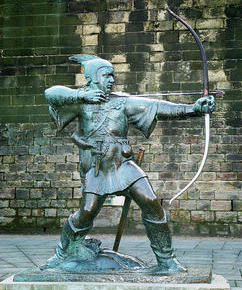
A monument to Robin Hood in Nottingham, England. It's by no means
certain that Robin was a real person; the first written accounts of
the legend did not appear until 1450 CE.
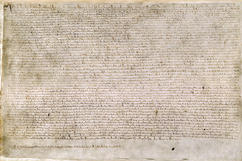
The Magna Carta was signed by King John in 1215. Edward I made it
part of English statute law in 1297.
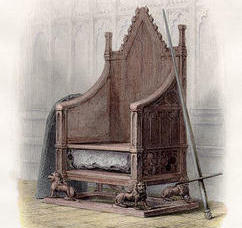
King Edward I had a special chair made to store the Stone of Destiny
under the seat. Called the
Coronation Chair, it has been used at the coronation of
English kings and queens for hundreds of years. In 1950, the Stone was
recaptured by four Scottish students and returned to Scotland for
four months until the British police took it back. In 1996,
in a symbolic gesture to improve relations between the two
countries, the British government returned the Stone to Scotland for
safekeeping when it was not needed for coronations. It now resides
in Edinburgh Castle.

Victims of the Black Death recently discovered in London. The plague
was so devastating that the genetic diversity of Britain is still
less than it was in 1300 CE.
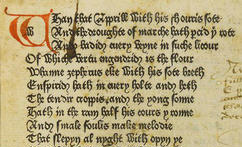
The opening page of the first English best-seller,
Canterbury Tales. Courtesy
the British Library.
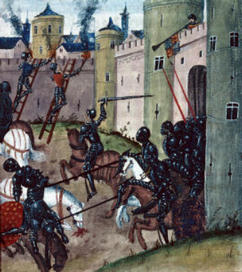
York soldiers storm London in 1471 during the War of the Roses.
Lancaster defenders rally to break the siege.
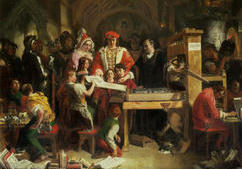
William Caxton, England's first printer and publisher, shows his
first book to King Edward IV in 1477.
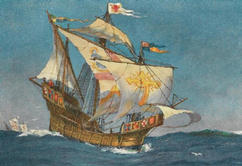
In 1497, Henry VIII commissioned John Cabot, a Venetian merchant, to
sail west to the Orient. Cabot landed in Newfoundland instead --
this was England's first exploration of the New World.
|